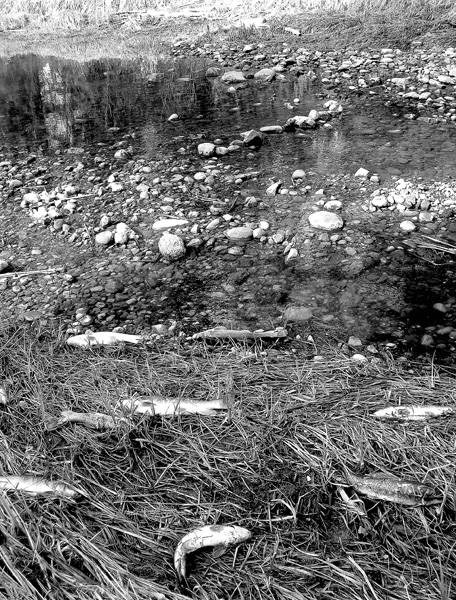A raft of dead fish has one local resident worried about water levels in the Sturgeon River.
Terry Boutin has lived on the banks of the Sturgeon a few minutes west of St. Albert for 19 years. On May 9, she says she was walking along the bank near her home when she saw scores of dead or dying white suckers near the river.
About 28 fish had already died on the shore when she got there, Boutin says, with many more trapped in shallow pools about 10 inches deep. "All the fish were trying to get upstream, and they'd get stranded and die."
She says she and her family tried to clear a path through the rocks for the fish, but most of them simply got stranded again. One escaped upriver. When she checked back a few days later, most of the fish were dead or gone.
The river is normally about a foot deep by her house at this time of year, Boutin says, but was less than three inches on that day. "In some places, it's just dry."
Boutin says she's concerned that climate change or water withdrawals may have been behind the fish-kill. "The golf courses are all pumping water out of that river," she says. "Maybe if they had a different source of water, it'd bring the [water] level back up again."
The incident had her worried about the state of the Sturgeon River. "Seeing all these fish stranded is kind of disheartening."
Not that simple, says biologist
Daryl Watters, a fisheries biologist with Alberta Sustainable Resource Development who works in the Sturgeon watershed, says this was the third reported fish-kill on the Sturgeon that he had heard about in 22 years. "It's not uncommon in the Sturgeon just by the nature of the river," he says, as it's very shallow and has little flow.
It's tempting to blame golf courses, Watters says, but we shouldn't jump to conclusions. Water withdrawals can contribute to low water levels, he notes, but so does low winter snow pack, as well as beaver dams.
"We've had low water conditions around Edmonton for a number of years," he says. "I don't think it's as simple as pointing a finger at one party and saying, 'That's why there's low water in the river.'"
Nor is it clear that water levels in the Sturgeon have actually decreased. Data from the Water Survey of Canada suggest flow rates in the Sturgeon at St. Albert on May 9 were a bit below average — about 2.02 cubic metres (or about 12 bathtubs) per second, compared to the average of 6.58 — but also show that rates can vary from as low as 0.5 to a high of 26. An analysis of the data found no detectable change in flow rates in the Sturgeon at St. Albert since the start of monitoring in 1914.
Golf courses are the second-largest consumer of water from the Sturgeon after crops and irrigation, according to Alberta Environment, accounting for about 18 per cent of licensed consumption. (Consumption refers to water removed and not returned to the river, and is distinct from the actual amount of water in the river.)
Just seven per cent of the river's mean annual flow is licensed for consumption, says Alberta Environment spokesperson Cara Van Marck, which is not expected to affect flow rates except in low-flow years. The basin is still open for new licenses, but the department tends not to issue them as the river has such an unpredictable flow.
This incident has been reported to Alberta Environment and Sustainable Resource Development, says Pat Brennan, chair of the Sturgeon River Watershed Initiative Society, and is under investigation. Fish-kills should be reported to the province as soon as possible to aid in investigations, he adds.
Fisheries officials can sometimes save stranded fish if they get there in time, says Watters, who has hauled trapped fish out of the Sturgeon before. "If this individual finds a situation where there's fish trapped, a quick phone call to Fish and Wildlife is a good start point."
Residents who spot stranded fish should call Fish and Wildlife at 1-800-642-3800.




